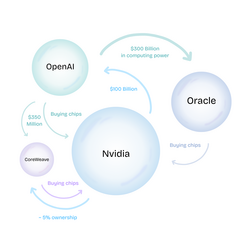Who Is Michael Burry?
Most people first heard of Michael Burry from the 2015 movie The Big Short. Christian Bale played him as the brilliant, socially awkward doctor-turned-investor who saw the 2008 housing crash coming years before anyone else. While Wall Street partied, Burry bet hundreds of millions of dollars that the U.S. housing market would collapse. He was mocked, threatened, and nearly ruined, but when the market finally crashed in 2008, his fund made more than 400 percent for his investors and he became a legend.
Since then, Burry has largely stayed out of the spotlight. He deleted his Twitter account years ago and rarely speaks to the press. When he does resurface, markets listen. In late October 2025, he quietly reactivated his account (@michaeljburry) and began posting again. His message is the same one he delivered before the last crash: most people are missing a gigantic bubble.

The Town That Went Crazy for Magic Beans
Imagine a small town where everyone suddenly becomes convinced that magic beans will solve world hunger in a few years. Prices of anything connected to magic beans explode overnight. Farmers, supermarkets, and new startups rush in. Money flows everywhere. To the average person on Main Street, it looks like the greatest boom ever.
This is the exact picture Michael Burry uses to describe the current artificial intelligence mania in late 2025.
Who Plays Each Role in the Story
The Farmer Selling the Machines – NVIDIA
NVIDIA makes the ultra-expensive chips (GPUs) that everyone needs to train and run modern AI models. A single large cluster can cost tens or hundreds of millions of dollars. In three years its stock rose more than tenfold, briefly making it the most valuable company on Earth.
The Giant Supermarkets – Microsoft, Amazon, Google, Meta
These tech giants have pledged hundreds of billions of dollars to build enormous AI data centers packed with NVIDIA chips. Every quarter they announce even bigger spending, and Wall Street celebrates.
The Bean Startups – OpenAI, Anthropic, xAI, and many more
Most of these companies still have almost no real paying customers outside the small circle of big tech companies. Their main funding comes from those same supermarkets.
The Money Is Going in a Circle
Here is the part most people miss: the dollars are traveling in a closed loop.
Microsoft invests billions in OpenAI.
OpenAI spends almost all of that money renting cloud servers from Microsoft and buying chips from NVIDIA.
Microsoft and NVIDIA then announce “record AI revenue.”
The same dollars get counted multiple times as “demand.”
Michael Burry’s core argument is that true outside demand (regular companies and ordinary people paying for useful AI) is still tiny compared to the hundreds of billions flowing inside this loop.
The Accounting Magic Trick
To make everything look even healthier, many companies quietly changed one key accounting rule: how long their equipment lasts.
A few years ago, a $50 million server room was expected to wear out in four years.
Now many say the same equipment will last six or eight years.
Result: annual depreciation expense falls sharply, and reported profits jump dramatically even though nothing changed in the real world.
Burry likens it to an airline suddenly declaring its 30-year-old planes will fly for 60 years. Earnings look fantastic on paper, but the planes are still old and costly to operate.
Old Chips Are Still Expensive to Run
A three-year-old NVIDIA chip consumes two to three times more electricity than the newest models. Electricity is now the largest operating cost for most AI data centers. Keeping outdated chips running is like flying a 1970s fuel-guzzler only on holidays: it is not profitable; it simply postpones the pain.
NVIDIA’s Hidden Share-Dilution Problem
Since 2018 NVIDIA has paid employees with massive amounts of stock. Even after spending more than $100 billion buying back shares, there are still more shares outstanding today than seven years ago. Every dollar of profit now has to be shared among more owners, so real earnings per share are far lower than the headline figures suggest.
The Mystery at the Center: OpenAI
OpenAI sits in the middle of the circle, taking in tens of billions and reporting explosive growth, yet it remains private and unusually secretive. Burry keeps asking a simple question almost nobody answers: who actually audits OpenAI’s books?
History Rhymes: Warren Buffett’s 1969 Warning
In 1969 a young Warren Buffett closed his investment partnership because stocks were wildly overpriced. The next decade saw the stock market lose more than 50 percent of its value after inflation. Burry recently reposted Buffett’s 1969 letter, suggesting today’s AI valuations feel eerily similar.
What Happens When the Music Stops?
Burry is not saying AI technology will vanish. Useful AI will become part of everyday life, just as the internet did after the dot-com bust. He is saying the current financial structure (circular money, accounting tricks, and sky-high valuations) cannot last.
When the supermarkets stop giving away free credits and chips, and when investors finally demand real profits from real customers, today’s prices will look absurd.
Why Michael Burry Could Be Wrong This Time
Even the best investors get it wrong sometimes, and Burry has been early or outright mistaken before (Tesla 2020–2021, Chinese stocks, GameStop, and broad-market bears in 2023). Several powerful forces could prove him wrong again on AI.
First, real adoption is finally moving beyond the Big Tech circle. Enterprise AI spending reached $97 billion in 2025, and top companies now report 2–3× revenue growth from actual deployments. Generative AI users are on track to hit 378 million by year-end.
Second, this is physical infrastructure, data centers, power plants, copper, chips, not dot-com pets. History shows overbuilding in railroads or fiber optics eventually paid off.
Third, extending server lives from four to six years is legal, disclosed, and often justified by cooler, more reliable new chips.
Fourth, governments and CEOs desperately need productivity growth. They will keep money and power flowing to AI.
Finally, momentum is brutal. As long as earnings keep beating, valuations can stay sky-high for years. Shorts have expiration dates; euphoria does not.
Burry may spot real froth, yet the transformation could still be bigger and faster than almost anyone expects. Being early can feel exactly like being wrong, until the day it suddenly isn’t.
The Final Warning
In the magic-bean town, the crash comes the day people realize there are thousands of expensive machines sitting idle, mountains of debt, and almost nobody actually eating the beans.
Michael Burry believes the AI market in late 2025 is standing in exactly that place. He has promised a detailed report on November 25 with all the evidence. Whether the market listens or not, his warning is clear and simple: a bubble built on magic beans can grow enormous, but it cannot last forever. Sooner or later, someone has to eat the beans.



